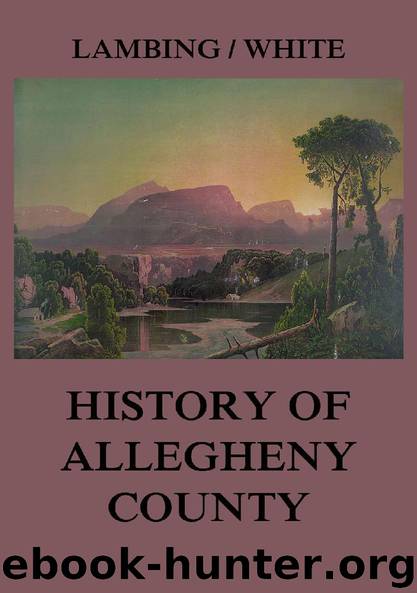Allegheny County: Its Early History and Subsequent Development by Andrew Arnold Lambing

Author:Andrew Arnold Lambing [Lambing, Andrew Arnold]
Language: eng
Format: epub
Tags: Geschichte
Publisher: Jazzybee Verlag
Published: 2018-03-19T23:00:00+00:00
INDIAN WARS.
The settlement of the region north of the rivers was retarded from various causes, but mainly because of the Indian troubles During the Revolutionary war the state paid her troops in certificates, or "script," promising to provide for their redemption out of the public lauds. Acts of Assembly looking to this end were passed in 1780 and 1781. By Act of March 12, 1783, the region north of the rivers was divided into two sections by a line starting at the mouth of Mogulbughtition Creek, (Pine Creek, above Kittanuing), and running due west to the Ohio State line, passing a little south of New Castle. All south of that line were called "depreciation" lauds, and all north "donation" lands. The "script" had greatly depreciated, but it was received by the State at par value in payment of land in the Depreciation District. Donations were also made to the soldiers of lands in the Donation District.
At that time the lands were not surveyed nor the Indian title extinguished. That title was extinguished by the treaty of 1784; but delays occurred in the surveys by Indian hostilities.
The Indians of the Northwest, along the lakes from Buffalo to Detroit, and down to the Ohio river, as a general rule, took side with the English in our Revolutionary struggle, and, aided and encouraged by renegade whites, committed frightful barbarities upon the frontier settlements. These outrages were continued after the peace with England in 1783, and increased in extent and violence from 1790 to 1794.
Three notorious Tories, Alexander McKee, Matthew Elliott and Simon Girty, who had lived at Fort Pitt and were familiar with the whole country, instigated and led on the Indians.
To check the Indian raids and chastise the savages, the United States government organized two expeditions, one under Gen. Josiah Harmar and the other under Gen. Charles Scott. The former, in the fall of 1790, with 1,400 men, regulars and militia, marched to the Maumee, and the latter, with 750 men, in the summer of 1791, marched to the Wabash. These expeditions ravaged the Indian country, destroying the crops and burning villages, but did not succeed in suppressing Indian raids; rather provoked them to greater outrages.
A more formidable expedition was then sent out under Gen. Arthur St. Clair. In April, 1791, troops, munitions, etc., were gathered at Pittsburg and sent down the river to Cincinnati, from which place St. Clair marched, in September, with 2,300 men for the headwaters of the Wabash. The troops were mainly militia, unaccustomed to discipline, insubordinate and demoralized, so that by desertions, etc., his army was reduced to about 1,400 when he reached the headwaters of the Wabash, on November 3, 1791. On the morning of the next day, November 4, the Indians attacked his camp and a bloody battle ensued, resulting in a loss, killed and wounded, of eight hundred and ninety-six men and sixty-eight officers—the most disastrous battle with the Indians since Braddock's defeat. The remnant of the army had to retreat, exposing the whole frontier of near a thousand miles to the merciless raids of the savages.
Download
This site does not store any files on its server. We only index and link to content provided by other sites. Please contact the content providers to delete copyright contents if any and email us, we'll remove relevant links or contents immediately.
| Africa | Americas |
| Arctic & Antarctica | Asia |
| Australia & Oceania | Europe |
| Middle East | Russia |
| United States | World |
| Ancient Civilizations | Military |
| Historical Study & Educational Resources |
The Body: A Guide for Occupants by Bill Bryson(5026)
Liar's Poker by Michael Lewis(3412)
Into Thin Air by Jon Krakauer(3346)
Tuesdays With Morrie by Mitch Albom(2722)
Into the Wild by Jon Krakauer(2607)
The Diamond Cutter by Geshe Michael Roach(2036)
My Dark Places by James Ellroy(1906)
Columbine by Dave Cullen(1839)
Helter Skelter: The True Story of the Manson Murders by Vincent Bugliosi & Curt Gentry(1711)
Extraordinary, Ordinary People by Condoleezza Rice(1482)
Everything in Its Place by Oliver Sacks(1467)
Pilgrim at Tinker Creek by Annie Dillard(1406)
Into the wild by Jon Krakauer(1401)
You Can't Touch My Hair by Phoebe Robinson(1384)
The Girls: Sappho Goes to Hollywood by Diana McLellan(1298)
Dark Towers by David Enrich(1229)
Betrayal by Gregg Olsen(1219)
Call Sign Chaos by Jim Mattis & Bing West(1203)
Remedy and Reaction by Paul Starr(1170)
